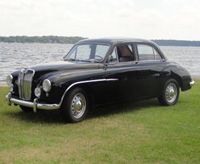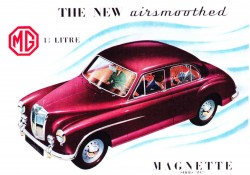A Brief Magnette History

 This article, which originally appeared in “Safety Fast” magazine, provides an insight into the production of the ZA and ZB Magnettes. NAMGAR wishes to thank the Editor of “Safety Fast”, Andy Knot, and authors, Malcolm Eades and Gunter Grasskamp from the Magnette Register of the MG Car Club (UK), for their permission to publish this article.
This article, which originally appeared in “Safety Fast” magazine, provides an insight into the production of the ZA and ZB Magnettes. NAMGAR wishes to thank the Editor of “Safety Fast”, Andy Knot, and authors, Malcolm Eades and Gunter Grasskamp from the Magnette Register of the MG Car Club (UK), for their permission to publish this article.
“The design of the Magnette started with Gerald Palmer’s return to Cowley in 1949, when he left Jowett. In October 1953, the MG stand at the London Motor Show featured a green ZA Magnette with beige interior and a grey/grey car, both of which had been completed only a short time before the exhibition opened. Because of production problems the finished cars did not correspond with the advance publicity material in all respects: they still lacked quarter lights and the advertised wooden dashboard could not be produced because of materials shortages.
“This situation was improved in March 1955 when, after about 6,000 cars had been produced, supplies of Italian walnut became available. Prior to this, the model was uprated with fog lights and bumper over-riders as standard, which continued throughout production. Presumably this was intended to eliminate any difficulties arising from the other changes to the spec. The cars were visibly well equipped in other ways too. A heater was offered as standard, which was still not the case with other more expensive models, and leather seats were also included.

Mixed Reception
“At £915 the ZA Magnette cost less than the Y-Type (£989) and was competitive with the few sporting saloons on offer from other marques. But whilst Palmer’s very similar XPAG-engined Wolseley 4/44 attracted praise in 1952, the launch of the Magnette unleashed an outcry amongst enthusiasts. The re-use of the glorious Magnette name on a family saloon with Wolseley bodywork, an Austin engine and a dummy radiator was not the sort of thing they had come to expect from MG, although it was in fact far from a copy of the 4/44. In order to emphasise the character of the MG in contrast to the sedate but luxurious Wolseley the bodywork was made two inches lower, which not only looked more sporty but assured better handling. However, this had the result that the two models shared very few body panels. Apart from the roof, the front doors and the boot-lid, the panels were not interchangeable! As the Magnette sits lower, the floor pan, the sills and the front and rear wings were different. Furthermore, each car carries its own traditional radiator grille so their bonnets are not the same either.
“Nevertheless, the Magnette started a new era at Abingdon, It was the first MG built with a unitary body. Naturally, this brought its own production problems, because thus far MGs had always been chassis-built, as was still seen in the TF and from I955 the MGA. So it was no wonder that the initial build time for a Magnette could be up to four weeks. After 140 vehicles had been built this reduced to one week, which then became the norm. Full series production began in February I954 after the rear axle was modified on the instructions of John Thornley. The bodies were delivered, fully painted, by Pressed Steel in Swindon, with the power train coming from Longbridge.
More Power and the ZB
“July 1956 only minor details were changed, but t en the engine received some more treatment, having been proved in service and already used in the MGA. By increasing the compression ratio from 7.15:I to 8.3:I and fitting larger H4 twin carburettors and modified inlet and exhaust valves, the output was raised to 68bhp. Later that year the ZB Magnette appeared, with simplified chrome body-trim (Gerald Palmer disapproved, but had had by then left BMC) and interior modifications. For an extra £25 the prospective buyer could opt for the Varitone model. This offered a larger rear window and a two tone colour scheme. For a further £50 the customer could also have an automatic transmission fitted, However, the first few automatic cars made it clear that the transmission didn’t work properly and were recalled for modification in 1958. The “Manumatic clutch” was never popular and was no longer fitted from October 1958. Anyone who had opted for it and later realized that his £50 had been poorly invested could have a conventional transmission retrofitted for the sum of £75.
Sporting Magnettes
“The Magnette never provided MG with a recipe for sporting successes, with its relatively poor power to weight ratio. Thoughts of switching to six cylinders or to the already developed twin-cam engine were quickly dropped. Nonetheless three Magnettes took part in the 1955 Monte Carlo Rally under the name of ‘The Three Musketeers’, admittedly without notable success. Only the first and third place in the Silverstone Production Car Race in the same year brought the desired press attention.
“A year later Nancy Mitchell achieved third place in the Ladies Competition at the Monte Carlo Rally. But she only won the Ladies European Rally Championship because she competed for the rest of the season in an MGA. Pat Moss stayed in the Magnette without success. In 1957 the Magnette disappeared from the Works teams, and it was only deployed by BMC as a support vehicle for camera teams. It was, however, campaigned in subsequent years by privateers.
“The Magnette recorded its greatest sporting successes in stock car races in the ‘60s and ‘70s. With its great stability it was ideally suited to this. However, by this means a large number of Magnettes were consigned to a glorious but destructive fate. The Z Magnette finally ceased production in December 1958 after 36,60I cars had been made. These production figures had, hitherto, never been achieved by any other MG.”
For further information on the history of the Magnette, visit the MG Car Club Magnette Register.


Comment by: Allen H Bachelder
Not a silly question at all. MG started designating models roughly alphabetically, beginning with the C type in 1931, This was followed by D, F, J, L, M, N, P, Q, R, S, T, V and W types before the war, and after the war, T types were continued, along with a new Y type and finally a Z type, before starting all over again with the MGA, MGB, and MGC. Some of these models appeared in various generations designated with a second letter. Hence we have TA, TB, TC, TD, and TF models. The Y type was simply a “Y” until updated with the YB, and the earlier Y types thus became YAs in retrospect. The only remaining letter was Z – hence our “Z” Magnettes, the ZAs being produced from 1953 to 1955, and the upgraded ZBs being produced from 1956 until 1958. The MGC was the last model designated alphabetically in this system, although the MGBs carried on for another 11 years.
Numerous letters were skipped along the way, and it seems strange to me that the S, V, and W models were all designated SA, VA, and WA, as though second generations of these models were anticipated. Perhaps the interruption imposed by WW II prevented the likes of SBs, VBs, and WBs? At any rate, I hope this answers your question about ZBs. You can find out more at here.
You can also find out more about your ZB by joining company with our Z Magnette Group – a NAMGAR special interest chat list. Contact me at waywardmgs@comcast.net for more information.
Comment by: Michael Mitchell
What Does the ZB Stand For? I’ve Owned a 1958 ZB Magnette Since 1972. Silly Question?? GraciaZ, Michael.
Comment by: Steve Hanegan
What lovely cars! I am quite glad to own mine, and look forward to retrieving it from its’ temporary museum home…